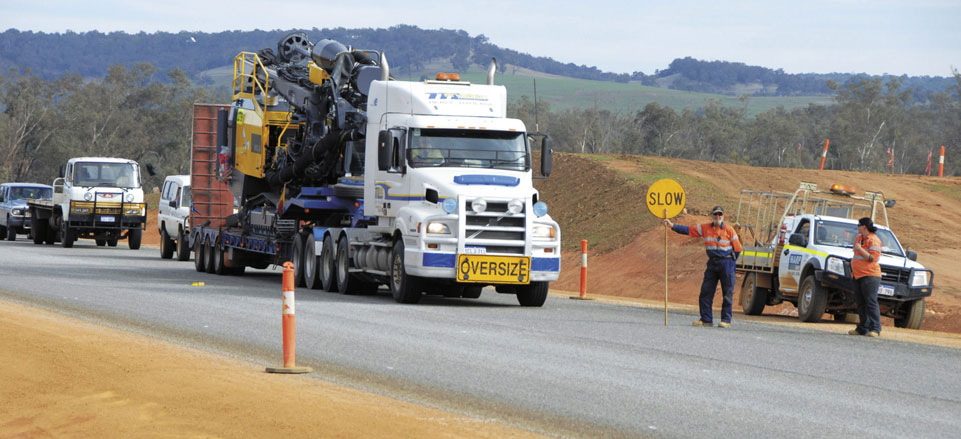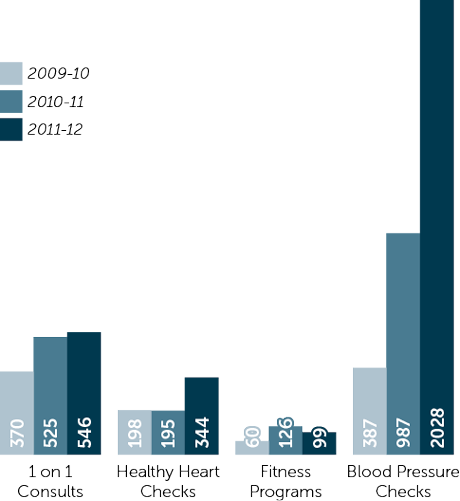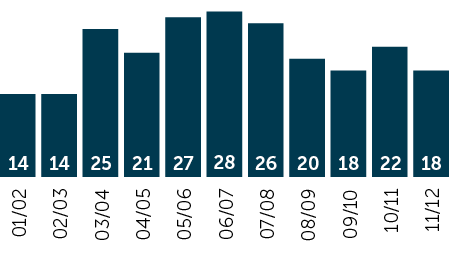SAFETY, HEALTH & WELLBEING

THINK SAFE, WORK SAFE, HOME SAFE
The safety, health and wellbeing of our people is essential to the success and sustainability of our business. An operative Safety, Health and Wellbeing culture relies on effective systems and processes in place, involving a commitment to safety by 'living' the ideals in our day to day behaviours.
Key Performance Indicators
| Indicators | 2010-11 Actual | 2011-12 Target | 2011-12 Actual | Result | Ref |
|
Fatalities |
0 |
0 |
0 |
|
85 |
|
Frequency Rate |
3.4 |
0 or 10% reduction |
2 |
|
85 |
|
Incidence Rate |
0.65 |
0 or 10% reduction |
0.36 |
|
85 |
|
Severity Rate |
0.0 |
0 or 10% reduction |
0.0 |
|
85 |
- Frequency rate is (the number of LTI/Ds over the previous 12 months)*1,000,000 divided by the number of hours worked during that 12 month period.
- Incidence rate is (the number of LTI/Ds divided by the number of employees)*100.
- Severity rate is (the number of LTI/Ds that resulted in 60 days or more lost divided by the total number of LTI/Ds)*100.
Recognition
IPAA Lonnie Awards
- Special Commendation 'Occupational Safety, Health and Injury Management'
2011 Annual Report
Introduction
Our corporate safety slogan 'Think Safe – Work Safe – Home Safe' serves as a reminder of the emphasis we place on behavioural safety, safe work practices and ongoing health and lifestyle education to support the wellbeing of our people.
Achievements
Third Party and Work Safe Plan Certification
Our Occupational Safety and Health Management System (OSHMS) was assessed and re-certified to Australian Standard 4801 in October 2011. Corporately, we are proudly in the process of undergoing assessment to maintain our WorkSafe Plan – Gold Certification.
Organisational OSH Commitment and Engagement
We continue to be committed to providing a safe and healthy work environment for our people that is based on strong collaborative relationships and visible leadership at all levels of the organisation. Through the OSHMS's multi-layered committee structure (at both the Directorate and regional level) our management plans are based on corporate initiatives, local issues and consultation, which thereby ensures that we are aware of our risks and can manage them effectively. Our committees comprise senior management, employees and elected safety and health representatives. The commitment from these committee representatives allows a forum for consideration of contentious issues, and provides a conduit through which all our people can be informed and involved in OSH matters.
In February 2012 a Safety, Health and Wellbeing (SHW) Communication Working Group was established with the intent of bringing together individuals from across the organisation to discuss methods of effectively communicating SHW and enhancing the SHW culture. Initiatives from this working group are referred to the Corporate Committee for endorsement.
Safe Work Week 2011
All Regions and Directorates were encouraged to organise activities for Safe Work week to put safety in the spotlight and increase awareness of how our overall health and wellbeing can impact our safety at work and at home. In 2011 we celebrated Safe Work week over the period 31 October to 4 November. Activities included a nutrition presentation, healthy cooking demonstrations, safety video's and Take 10@10 toolbox safety talks.
The biggest event during the week was the Health Expo which included a variety of services that staff could take part in and these included iridology, reflexology, live blood screening, seated massage, upper and lower body fitness testing and blood pressure testing. We will again host this successful event in 2012.
Corporate OSH Management Systems Training
OSH for Line Managers is a one day intensive training course customised for Main Roads with relevance to our OSHMS. The course contains five modules including OSH Law; OSH Management Systems; Hazard Management; Incident and Injury Management; and OSH Leadership, Culture and Communication.
The objectives of the course are to make line managers aware of their legal responsibilities and of potential exposures to legal risk that could impact Main Roads as an agency. The course also aims to provide line managers with OSH management skills enabling them to implement the OSH management systems in their area of responsibility and to effectively carry out their OSH activities. Over the last three years, more than 90% of our managers have completed this training.
Partnering with ISA Safety Managers - Community of OSH Practitioners
We have commenced quarterly OSH practitioner meetings with Directorate and regional safety personnel including our ISA partners. The meetings contribute to Main Roads' OSH Principles and Objectives through the development and sharing of best practice knowledge, skills and work practices. The community works collaboratively to:
- Discuss issues relevant to OSH and participate in joint problem solving.
- Foster the sharing of knowledge, skills and work practices utilising a community approach.
- Challenge and recommend improvements to existing policies, processes and practices.
- Identify practices that would benefit from standardisation and implement best practice across regions while recognising local differences.
- Develop new capabilities in OSH skills and competencies.
Taking Proactive Safety, Health and Wellbeing Preventative Measures
We continue with our proactive approach in helping our people manage their health. Approximately 230 employees took part in our annual flu vaccinations and around 400 employees participated in skin cancer screening programs. We also continued our commitment to providing a confidential Employee Assistance Program for our staff. The Program is an organisation-funded counselling service which provides support to employees who may be experiencing problems, affecting their job performance or personal lives. The graph below shows the participation of our employees in various initiatives offered by the Health and Wellbeing service provider.
Exercise and Consult Participation

Earlier in the year we released our Corporate Health and Wellbeing Calendar listing dates of community events that we encourage staff to participate in. Such events include the City to Surf, Freeway Bike Hike, Great Bike Ride, HBF Run for a Reason and Corporate Cup activities.
The Health and Wellbeing program service provider has introduced an online wellness tracker for our staff to track and measure their own progress towards improving their wellbeing. The online tool has become popular with staff who use this tool to update their exercise regimes, weight, BMI, glucose and blood pressure levels. We are also in the process of introducing a Safety, Health & Wellbeing Index that will allow us to determine the perceptual and actual effectiveness of our Safety, Health & Wellbeing initiatives.
In working towards our goal of reducing musculoskeletal injuries in the office, we have completed over 50 work station ergonomic assessments this year and arranged training courses that covers manual tasks and ergonomics in the workplace.
PERFORMANCE REVIEW
Our reporting processes focus on a combination of lag and positive indicators to capture the outcomes of incidents and identify the proactive behaviour our staff engages in to determine and manage hazards in the workplace. Some of these indicators include hazards reported, close-out of these hazards, attendance at OSH committees and toolbox meetings, induction of new staff and undertaking workplace inspections.
Lost Time Injuries
LTI/D is defined as an injury or disease that results in the affected employee being unable to work for one full shift or longer. The following graphs show our performance and that of our contractors during the year:

*We rely heavily on all contractors to provide accurate information to Main Roads within the required timeframe. LTI Contractor statistics are accurate at the time of reporting and are to be considered as estimated.
During the past year, we sustained 4 LTI/D, resulting in a decrease in our Lost Time Injury/Disease Frequency Rate from 3.4 to 2 serious injuries sustained per million hours worked. Our contractors also sustained 17 LTI/D resulting in an increase in their LTIFR from 3.5 to 5.4.
Although our ultimate goal is for zero harm, we had fewer LTI's and NLTI's this year, which is an improvement on our performance from last year. The majority of our serious incidents involved manual handling/ergonomics, equipment and slips/trips/falls. In the next year, we will again be focusing our attention on minimising the likelihood of these risks reccurring. A breakdown of our incidents by type is outlined below.
Summary of all incidents by type and severity
| Incident Type | LTI | NLTI | NMI | Total |
|
Equipment |
- |
10 |
13 |
24 |
|
Slips/Trips/Falls |
2 |
11 |
7 |
20 |
|
Other |
- |
8 |
8 |
16 |
|
Vehicle |
- |
1 |
12 |
14 |
|
Sprains/Strains |
2 |
25 |
1 |
28 |
|
Environment |
- |
1 |
- |
1 |
|
Human Factor |
- |
4 |
4 |
8 |
|
Bites/Stings |
- |
4 |
2 |
6 |
|
Health |
- |
1 |
- |
1 |
|
Total |
4 |
65 |
47 |
118 |
WORKERS' COMPENSATION AND INJURY MANAGEMENT
During the past year, Main Roads incurred 18 workers' compensation claims in total. Of these claims, five have been finalised, with none pended or declined; 100% of our injured workers returned to full time work within 13 and 26 weeks of sustaining their injury. The graph shows our performance compared to previous years.
Claims Lodged (Period Ending 30 June)


Looking Ahead
- Implementing the Occupational, Health and Wellbeing Strategy.
- Review OSHMS in alignment with the upcoming Workplace Safety and Health Laws (WA).
- Increased training to all levels of management on Workers' Compensation and Injury Management.
- A strong focus on developing Safe Work Method Statements and Job Safety Analysis.
- Implementing an electronic hazard and incident reporting management system.

 previous page
previous page
 previous page
previous page
